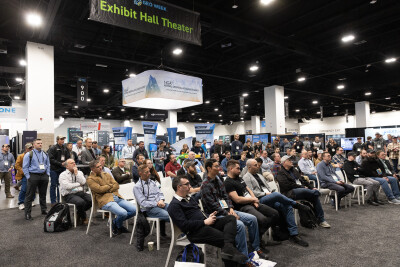At SPAR 3D this year, Kaarta was on hand for the launch of its newest handheld lidar scanner, the Contour. The device integrates a +/- 3 cm lidar sensor, IMU, camera, battery, and a touch screen into a small form factor to enable “decision-making at the point of work.”
The device is built around the Kaarta engine, a mapping and localization algorithm that processes sensor data and displays the results in real-time on the touch screen. The touch screen also enables users to pause, rewind, and rotate the model in progress as necessary to spot check their work in the field.
“That real-time aspect is important,” Kaarta CEO Kevin Dowling told SPAR 3D, “because you can see if you missed an area and not have to go back later—those call-backs are what people hate.”
Another benefit of the Kaarta engine is speed. The company says that Contour can be used to scan a typical 10,000 squad meter building in about 2.5 hours.
“We were working with a government customer who wanted to scan large areas,” Dowling said, “and we did a very large hallway in five or six minutes. I asked the gentleman there how long it would have taken with a tripod-based scanner. Hours. With setup and post-processing, it would have taken many hours.”
Kaarta’s engine, like many SLAM algorithms, enables mapping in areas where GPS coverage is denied. But it also enables some unique workflows that exploit multiple means of capture.
He showed me a video of a Kaarta employee mapping an outdoor complex with the Stencil, Kaarta’s other handheld device. As the arrow representing him moved down the stairs, a point cloud of his surroundings was generated in real-time. When he gets to the bottom of the stairs, he closes the loop. But Downling tells me he doesn’t have to go back to the starting point, because the system has low enough drift and high enough accuracy that it can implicitly close the loop.
This accuracy enabled the employee in the video to mount the Stencil on a UAV and add aerial data to the model. As the UAV scanned the building complex, Dowling told me that the the algorithm was registering its point cloud to the map already gathered on foot. That sort of functionality means you can take multiple approaches to ensure a full 3D map.
Kaarta is an algorithm company that integrates hardware offered by other vendors. This means that as the hardware available on the market advances, Kaarta’s products will advance with them. “As the lidars improve, as the processing improves, as the batteries improve,” Dowling says, “everything will just get better. In fact, we believe this sort of form factor will make the trolley and backpack obsolete some day.”
First units are shipping to customers during April.






